Chapter 2 The Backprop Algorithm
|
Copyright by Donald R. Tveter |
|
Commercial Use Prohibited |
2.1 Evaluating a Network
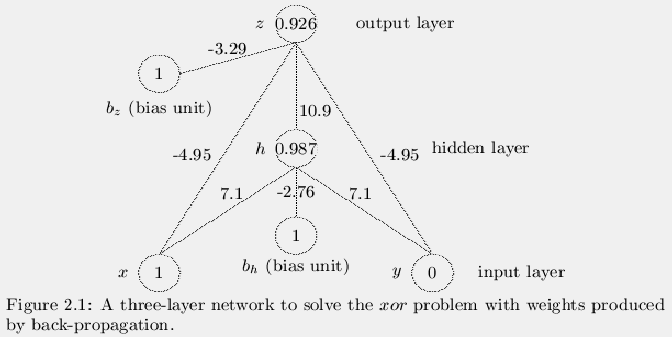
Figure 2.1 shows a simple back-propagation network that
computes the exclusive-or (xor) of two inputs, x and y. The xor
function, z = xor(x,y) is defined as follows:
In this figure the circles represent neurons or units or
nodes that are extremely simple analog computing devices. The
numbers within the circles represent the activation values of the units.
The main nodes are arranged in layers. In this case there are three
layers, the input layer that contains the values for x and y, a
hidden layer that contains one node, h and an output unit that
gives the value of the output value, z. The hidden layer is so-named
because the network can be regarded as a black box with inputs and
outputs that can be seen but the hidden units cannot be seen. There are
two other units present called bias units whose values are
always 1.0. For now we are not going to claim that they are part of any
one layer. Most of the time when a network is drawn the bias units are
not even shown. When other writers want to emphasize the presence of a
bias unit there is often only one unit shown in the diagram of the
network and that one unit is used for the entire network. This is
probably the only example where we will show the bias units at all. The
lines connecting the circles represent weights and the number
beside a weight is the value of the weight. Much of the time
back-propagation networks only have connections within adjacent layers
however this one has two extra connections that go directly from the
input units to the output unit. In some problems, like xor these
extra input-output connections make training the network much faster.
Networks are usually just described by the number of units in each layer
so the network in 2.1 can be described as a 2-1-1 network with
extra input-output connections. In this report this will be shortened
to 2-1-1-x.
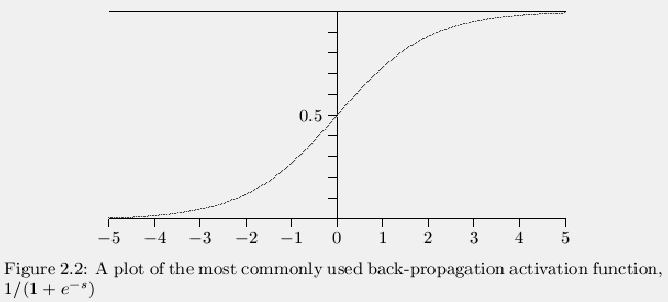
To compute the value of the output unit, z, we place values for x
and y on the input layer units. Let these values be 1.0 and 0.0
as in figure 2.1. First we compute the value of the hidden layer
unit, h. The first step of this computation is to look at each lower
level unit and the bias unit that is connected to the hidden unit. For
each of these connections, find the value of the unit and multiply by
the weight and sum all the results. The calculations give:
In some neural networks we might just leave the activation value of the
unit to be 4.34. In this case we would say that we are using the linear
activation function, however backprop is at its best when this value is
passed to certain types of non-linear functions. The most commonly used
non-linear function is:
where s is the sum of the inputs to the neuron and v is the value of
the neuron. Thus, with s = 4.34, v = 0.987. This particular
function will be called the standard sigmoid in this manual. Quite
often it is called the logistic function. The general function used to
compute the value of a neuron can be called the activation
function , squashing function or transfer function .
The calculations for the output unit, z are:
Of course, 0.926 is not quite 1 but for this example it is close enough.
When using this particular activation function for a problem where the
output is supposed to be a 0 or 1 getting the output to within 0.1 of
the target value is a very common standard but other people may want to
get to closer than this while others don't want to get even this close.
With this particular activation function it is actually somewhat hard to
get very close to 1 or 0 because the function only approaches 1 and 0 as
the input to the function approaches ¥ and -¥. Figure
2.2 shows a graph of the function with the y direction
stretched with respect to the x direction. There are other activation
functions you can use that make it easier to get closer to the exact
targets. The other values the network computes for the xor function
are:
The formulas for computing the activation value for a neuron, j can
be written more concisely as follows. Let the activation value for
neuron j be oj. Let the activation function be the general
function, f. Let the weight between neuron j and neuron i be
wij. Let the net input to neuron j be netj, then
where n is the number of units feeding into unit j and
2.2 Training a Network
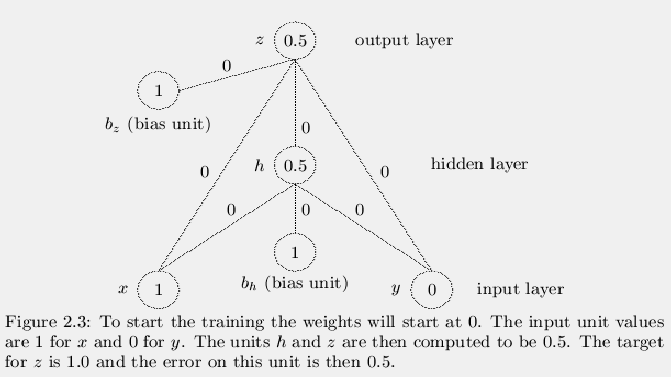
Figure 2.3 shows a 2-1-1-x xor network before it has been
trained to compute the xor function. In this example the network
weights will all start out at 0 (a bad idea in general but it works
here) and the training process will try to adjust the weights so that
the answers come out right. It will work as follows. First
put one of the patterns to be learned on the input units. Second, find
the values for the hidden unit and output unit. Third, find out how
large the error is on the output unit. Fourth, use one of the
back-propagation formulas to adjust the weights leading into the output
unit. The idea is to try to make the answer come out just a little bit
closer to the right answer. Fifth, use another formula to find out
errors for the hidden layer unit. Sixth, adjust the weights leading
into the hidden layer unit via another formula. Repeat steps one thru
six for the second, third and fourth xor patterns. Even after all
these changes to the weights the answers will only be a little closer
to the right answers and the whole process has to be repeated many
times. Each time all the patterns in the problem have been used once
we will call that an iteration although often other people call
this an epoch .
We will now look at the formulas for adjusting the weights that lead
into the output units of a back-propagation network. The actual
activation value of an output unit, k, will be ok and the target
for unit, k, will be tk. First of all there is a term in the
formula for dk, the error signal :
where f¢ is the derivative of the activation function, f. If we
use the usual activation function:
the derivative term is:
The formula to change the weight, wjk between the output unit, k,
and unit j is:
where h is some relatively small positive constant called the
learning rate . With the network in 2.3 with h = 0.1 we
have:
|
dz = (1 - 0.5) * 0.5 * (1 - 0.5) = 0.125 |
|
|
wzx ¬ 0 + 0.1 * 0.125 * 1 = 0.0125 |
|
|
wzy ¬ 0 + 0.1 * 0.125 * 0 = 0 |
|
|
wzh ¬ 0 + 0.1 * 0.125 * 0.5 = 0.00625 |
|
|
wzbz ¬ 0 + 0.1 * 0.125 * 1 = 0.0125 |
|
The formula for computing the error dj for a hidden unit,
j, is:
|
dj = f¢(netj) |
å
k
|
dk wkj. |
|
The k subscript is for all the units in the output layer however in
this example there is only one unit. In the example, then:
|
dh = 0.5 * (1 - 0.5) * 0.125 * 0.0.00625 = 0.000195313. |
|
The weight change formula for a weight, wij that goes between the
hidden unit, j and the input unit, i is essentially the same as
before:
The new weights will be:
|
whx ¬ 0 + 0.1 * 0.000195313 * 1 = 0.0000195313 |
|
|
why ¬ 0 + 0.1 * 0.000195313 * 0 = 0 |
|
|
whbh ¬ 0 + 0.1 * 0.000195313 * 1 = 0.0000195313 |
|
The activation value for the output layer will now be 0.507031. If
we now do the same for the other three patterns the output will be:
Sad to say but to get the outputs to within 0.1 requires 20,862
iterations, a very long time especially for such a short problem.
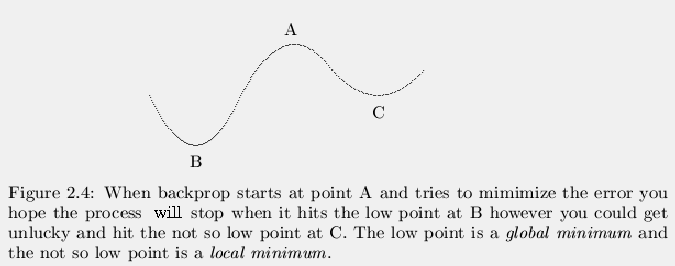
Fortunately there are a large number of things that can be done to
speed-up the training and the time to do the xor problem can be
reduced to around 12-20 iterations or so. The very simplest thing to
do is to increase the learning rate, h. The following table shows
how many iterations are used for different values of h.
Another unfortunate problem with backprop is that when the learning rate
is too large the training can fail as it did in the case when h =
3.0. Here, after 10,000 iterations the results were:
where the output for the last pattern is 1 not 0. The geometric
interpretation of this problem is that when the network tries to make
the error go down the network may get stuck in a valley that is not the
lowest possible valley. For instance, suppose the error landscape is
like the one shown in figure 2.4. There is one valley on the
left that solves the problem but there is a shallower valley on the
right that only gets some of the output values correct. This shallower
valley is called a local minimum and the valley that gives the
perfect results is called a global minimum , that is the best
minimum that you can find. Once you go down into the shallow valley, if
there is no path downhill that will get you to the deeper valley you are
permanently stuck with a bad answer. There are ways to break out of a
local minimum but in real world problems you never know when you've
found the best (global) minimum, you only hope to get a very deep
minimum.
The above method for changing the weights is actually a little less
orthodox than most Mathematicians can accept. The problem is that
when we used the first pattern we immediately changed the weight
wzh and used the changed weight to compute dh. Many
Mathematicians regard this as wrong but it works anyway. Instead they
normally say that the weight changes can be computed but none of them
should take effect until all the weight changes have been computed.
The calculations then work as follows. First the error for the output
unit is computed. The formula is:
|
dk = (tk - ok) ok (1 - ok) |
|
and the calculation is:
|
dz = (1 - 0.5) * 0.5 * (1 - 0.5) = 0.125. |
|
Next the weight changes for units leading into the output layer are
done with the formula:
giving the calculations:
|
Dwzx = 0.1 * 0.125 * 1 = 0.0125 |
|
|
Dwzy = 0.1 * 0.125 * 0 = 0 |
|
|
Dwzh = 0.1 * 0.125 * 0.5 = 0.00625 |
|
|
Dwzbz = 0.1 * 0.125 * 1 = 0.0125 |
|
Now the error for the hidden layer unit is computed using the formala:
and this gives the calculation:
|
dh = 0.5 * (1 - 0.5) * 0.125 * 0 = 0 |
|
The weight change formula is again:
This gives the calculations:
Now the weight changes are applied:
|
wzx ¬ wzx + Dwzx = 0 + 0.0125 = 0.0125 |
|
|
wzy ¬ wzy + Dwzy = 0 + 0 = 0 |
|
|
wzh ¬ wzh + Dwzh = 0 + 0.00625 = 0.00625 |
|
|
wzbz ¬ wzbz + Dwzbz = 0 + 0.0125 = 0.0125 |
|
|
whx ¬ whx + Dwhx = 0 + 0 = 0 |
|
|
why ¬ why + Dwhy = 0 + 0 = 0 |
|
|
whbh ¬ whbh + Dwhbh = 0 + 0 = 0 |
|
In this case it requires 25,496 iterations to get to within 0.1 of the
targets. In fact the ``wrong" method is sometimes a little faster on
some problems than the ``right" method although sometimes the ``right"
method is better. Again, learning can be made faster by increasing
h, but only to a point, as the data in the following table shows:
Both of the above methods for changing the weights are called
online or continuous update methods because the changes are
applied after each pattern is presented. To distinguish between the two
in this report they will be the ``wrong" and the ``right" or ``correct"
continuous update methods. There is a third alternative, the
batch or periodic update method. In this method the weight
changes for each weight are added up for every pattern and after all the
patterns have made their contributions the weights are changed only
once. Thus with the four patterns in the xor problem the weights are
changed only once for each iteration rather than 4 times as in either of
the continuous update methods. This means that less arithmetic needs to
be done each iteration and each iteration is therefore slightly faster.
On the other hand the continuous methods do more weight changes and take
more time per iteration but they normally require fewer iterations. I
can't give you an example just now of how long it takes to do the xor
problem with periodic updates because when the initial weights are all 0
the weight changes all cancel out and no learning takes place. This
doesn't happen in most problems but in all problems the network
converges faster when the weights start out with small random values, a
subject coming up soon.
A second variation on the periodic update method is to update more
than once for each iteration after just a fixed number of patterns are
processed. So if there were 1000 patterns to be learned an update
might happen every 100 patterns.
In some implementations of backprop the learning rate h for
periodic updates is automatically divided by the number of patterns.
In this software it is NOT.
2.3 A Derivation of Backprop
No text on backprop would be complete without a derivation of the
formulas so in this section they will be derived. Anyone with Math
Anxiety can skip this section without missing a thing.
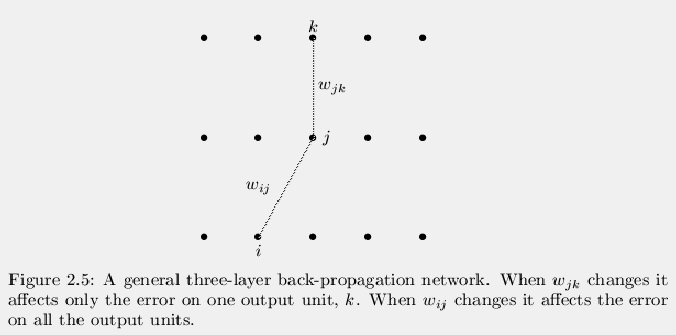
Figure 2.5 shows a general three layer network. In this
network, the following relationships hold:
Backprop is derived by assuming you want to minimize the error on
the output units over all the patterns using the following formula for
this error, E:
|
E = |
1
2
|
|
å
p
|
( |
å
k
|
(tpk - opk)2) |
|
where p is the subscript for the pattern and k is the subscript for
the output units. Then, tpk is the target value of output unit k
for pattern p and opk is the actual output value of output layer
unit k for pattern p. This is by far the most commonly used
error function however from time to time people have tried other
error functions. Notice that E is the sum over all the patterns
however we will assume that by minimizing the error for each pattern
individually E will also be minimized. Therefore we will drop the
subscript, p, from here on out and assume we are deriving the weight
change formulas for just one pattern.
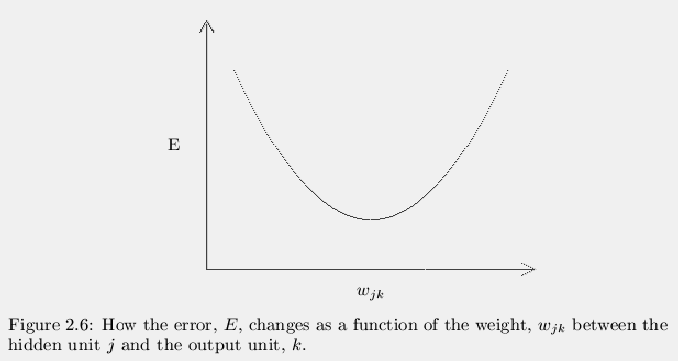
The first part of the problem is to find how E changes as the
weight, wjk, leading into an output unit changes. The second part
of the problem is to find out how E changes as wij, a weight
leading into a hidden layer unit, j, changes. Finding the formula for
the first part is the easiest. We simply write:
|
|
¶E
¶wjk
|
= |
¶E
¶ok
|
|
¶ok
¶netk
|
|
¶netk
¶wjk
|
= -(tk - ok) ok(1 - ok) oj |
|
This final term is the slope of the error curve for one weight,
wjk. A plot of the error will then look something like the curve
shown in figure 2.6. If the slope is positive we need to
decrease the weight by a small amount to lower the error and if
the slope is negative we need to increase the weight by a small amount.
To move farther down the error curve we can then make the weight change
as:
|
wjk ¬ wjk + (-h) (-(tk - ok) ok(1 - ok) oj) |
|
and the minus signs cancel out1. People usually define
the error signal, dk as follows:
and then the formula for weight changes for weights leading into the
output layer becomes:
Now we have to look at the second part of the problem that relates
the change in E to the change in the weight, wij. In this case,
a change to the weight, wij, changes oj and this changes the
inputs into each unit, k, in the output layer. The change in E with
a change in wij is therefore the sum of the changes to each of the
output units. The chain rule produces:
|
|
¶E
¶wij
|
= |
å
k
|
|
¶E
¶ok
|
|
¶ok
¶netk
|
|
¶netk
¶oj
|
|
¶oj
¶netj
|
|
¶netj
¶wij
|
|
|
|
= |
å
k
|
-(tk - ok)ok(1-ok)wjkoj(1-oj)oi |
|
if we let dj be:
With this definition the weight change can be written:
These derivations can be generalized to networks with more than 3
layers. The result is the following set of formulas. The first one
specifies the weight changes for weights leading into unit j, no
matter what layer unit j is in:
The second formula specifies the error signal for the output layer:
|
dj = (tj - oj) oj (1 - oj). |
|
The third formula specifies the error signal for unit j, in a hidden
layer with units k, above:
|
dj = oj(1 - oj) |
å
k
|
wjk dk. |
|
Footnotes:
1Notice the one minus sign before
h was introduced to make the error go down and it cancels with the
minus sign in the slope term. Then in doing the code the minus sign in
the slope term can be ignored if the minus sign with the h is also
ignored and that is what has been done in this code. For some weight
update methods the minus sign is added later.
File translated from
TEX
by
TTH,
version 2.60.
On 19 Jan 2000, 14:02.






